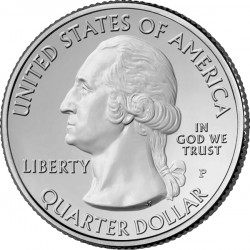
Appearing as the third strike in 2016 of the US Mint’s America the Beautiful Silver Bullion Coin™ Program will be the 2016 Harpers Ferry America the Beautiful Silver Bullion Coin. This coin number thirty-three out of fifty-six new coins that will be created under the program which debuted in 2010 and runs for eleven years.
The reverse of this coin will contain an image showcasing a portion of Harpers Ferry National Historical Park which is located in West Virginia. The final design will be chosen by the Treasury Secretary in time for an unveiling probably in early 2016. However, sometime in the previous year a series of design candidates for the coin should be released so that they may be reviewed by the appropriate individuals and groups.
On the obverse the coin will contain an image of the first President of the United States George Washington. His likeness will be seen on the obverse of all of the America the Beautiful Silver Bullion Coins as well as the sister series of circulating quarter dollars.
The America’s Beautiful National Parks Quarter Dollar Coin Act of 2008 which authorized these coins also dictates the specifications for the coin and states that each coin must be struck from five ounces of .999 fine silver with a diameter of three inches (this makes these coins the largest bullion pieces to be routinely struck by the Mint to date). The act also stipulates that the coins weight and fineness be edge inscribed on the piece to serve as an indicator that the coins content and purity is guaranteed by the American government.
In all, fifty-six new strikes will be created through the bullion coin program with each honoring a site of national interest such as a national park or national monument. To insure a fair representation of the country as a whole, only one site was chosen from each state, the District of Columbia and the five US Territories.
Typically, the Mint only sells its bullion pieces to a network of authorized purchasers and not directly to the public. This will also be the case for these America the Beautiful pieces. Those interested in obtaining some of them will have to do so through the authorized purchaser network who resells them for a small premium over the spot price of the precious metal contained within them.
As this is the third coin to appear in 2016, it will be preceded by two other America the Beautiful strikes which will honor Shawnee National Forest in Illinois and Cumberland Gap National Historical Park in Kentucky. It will be followed that same year by two other coins showcasing Theodore Roosevelt National Park in North Dakota and Fort Moultrie (Fort Sumter National Monument) of South Carolina.
Harpers Ferry National Historical Park in West Virginia
Few places in the United States can claim such an integral role in the history of the country as can Harpers Ferry National Historical Park in West Virginia. From Native American tribes living in the region thousands of years ago to the desegregation of American schools in just the last century, Harpers Ferry has been there prominent in one form or another.
Traces of the presence of Native Americans in the Harpers Ferry area date back millennia, but by the early 1700’s they had been driven out by the encroachment of European settlers. In 1751, a man named Robert Harper applied for a patent for the land deciding that the confluence of the Potomac and Shenandoah Rivers made an ideal location to build and harness the ample waterpower.
Under order of the first President of the United States George Washington, a federal armory was constructed at this location in 1799 – once again based on the waterpower that the nearby rivers could provide to aid in the creation of weaponry. The armory continued to produce weapons over the next several decades and was even able to assist in the outfitting of the famed Lewis and Clark Expedition.
With tensions increasing between the northern and southern states of the United States of America in the 1850’s, the armory was subject of an attack and seizure by abolitionist John Brown who hoped to incite a slave revolt. His actions, however, were met with force and after his capture he was hanged for his deeds but not before predicting the Civil War that would occur only a few years later.
During the American Civil War, Harper’s Ferry was seen by both sides as an extremely strategic location, not only for the manufacturing found there, but also for its access into the surrounding states. Therefore, possession of it was highly sought after and it actually changed hands from North to South and back again several times over the course of the war.
At the end of the war, Stoner College was built in Harper’s Ferry and operated as one of the first integrated schools in the nation. It remained in operation until the 1950’s when desegregation occurred in 1954.
Recognizing the importance of Harpers Ferry, it was declared a national monument in 1944 only to be redesignated a national park a few decades later in 1963. Today, hundreds of thousands of annual visitors take a few steps back in time and enjoy the Harpers Ferry we find there today.